|
One of the most common questions I get
asked in my “Ask Dr. Ron” forum
on Reef Central is, “What are these white spots on the
walls of my aquarium?” Such questions often include
a photo or two of a small circular or oval structure often
containing one or several small white dots. My reply is that
these are snail egg capsules. In aquaria, they are typically
deposited by female Nassarius snails as well the females
of a few other species. That is, of course, the short answer.
In reality these capsules form a part of the snail’s
life history that is really fascinating.
Here are links to a couple of the threads
which have pictures of the egg capsules: LINK
1, LINK
2, LINK
3
Primitive mollusks were probably animals that had separate
sexes which spawned by broadcasting their gametes into the
water column much as do many marine animals today. Broadcast
or “free” spawning is reproduction by simply releasing
the sex cells, or gametes, into the water column. If these
gametes, the sperm cells and eggs, are released in close enough
proximity, the sperm will fertilize the egg, and embryonic
development will begin. Subsequent to spawning and fertilization,
there are a number of potential development patterns leading
either directly to a small juvenile, or to a larva of some
sort and thence to a juvenile.
The one thing all of these modes of development
have in common is that they are unlikely to succeed. The odds
against successful reproduction are exceptionally high. Consider
that if a population of any animal is more-or-less stable
through time, all any female has to do is to produce two eggs
over her lifetime that successfully grow to reproductive adults.
These two eggs would replace her and her mate. Many free-spawning
animals live a long time, and reproduce yearly. Animals that
possess this mode of reproduction such as sea urchins, sea
cucumbers, some polychaete worms, such as the common aquarium
fire worms, clams and some snails will often produce hundreds
of millions of eggs for each spawning event. Over the course
of their lifetimes, they may literally produce billions or
even trillions of eggs. If only two need to survive until
the next generation, it can be easily seen that the odds against
survival is often billions or hundreds of billions to one.
Obviously, there would be great advantage
to being able to maximize the success of such reproduction;
the more successful the reproductive event, the more offspring
are left, and the more successful is the species. Natural
selection, with the subsequent evolution of the animals, has
resulted in many ways to cut the odds. The first one is to
have copulation and internal fertilization of the eggs. Eggs
that are broadcast into the environment have little chance
of fertilization, even if there is a male spawning nearby.
Most eggs and sperm broadcast into the water probably never
unite with a partner. Eggs may remain viable for periods of
a few hours to up to a day. Sperm generally are much shorter
lived and “run out of gas” within a couple of
hours.
Within the mollusks several groups of animals, notably for
aquarists, the chitons and the clams, have retained the primitive
mode of broadcast reproduction. The snails, however, generally
have abandoned it in favor of a process that is more likely
to be successful. This more successful mode consists of copulation
followed by internal fertilization. Such reproduction cuts
the odds significantly, and these animals produce far fewer
gametes over their lifetimes. However, to get from a broadcast
spawning ancestor to an animal that can utilize internal fertilization
to reproduce necessitates a lot of changes in both the female
and male plumbing. Interestingly enough, probably the best
group of animals to use to examine these changes is the vast
Class Gastropoda of the Phylum Mollusca, or as it is more
commonly known, the snails.
Some snails, including many of the so-called “turbo-grazers”
found in reef aquaria are broadcast-spawning animals. At the
complete other end of the spectrum are numerous snails, mostly
living in fresh water, that give birth to live young. The
actual number of snail species is unknown; the estimates range
from a low of about 30,000 to a high of over 100,000 species.
In either case, however, the huge number or species makes
the snails the second most species-rich group of animals after
the insects. However, not only are there a lot of snail species,
there are a lot of different ways to make a snail, and many
of these have different and unique ways to reproduce.
In my invertebrate zoology courses, I often
use the Class Gastropoda as examples of how animals change
to meet any contingency. Using this group as an example is
particularly good because in many cases, it appears that intermediate
forms have survived. In effect, the group is full of “missing
links.” Only here they are not missing. This is particularly
true when the changes in the reproductive system are concerned.
Apparently, primitive snails had very simple reproductive
plumbing; basically they had gonads and a duct to the great
out of doors, and simply spawned into the water. Today, snails
that are considered to be primitive, such as some of the group
containing Turbo, still have that type of reproductive
system. In the marine shelled snails, the other end of the
continuum is seen in the predatory snails such as the whelks.
In these animals, both sexes have highly modified reproductive
systems. The simple duct to the outdoors has changed in the
male to have internal sacs or vesicles to store sperm, glands
to produce nourishment for the sperm, and glands to provide
a fluid environment for the sperm. Additionally, the duct
has developed externally into a penis. In the female, the
duct has changed into a vagina, but additionally there are
compartments to store sperm after copulation and glands to
secrete nourishment for those sperm, as the female can often
store sperm for several months prior to use. Additionally,
the simple oviduct has been modified with glands to produce
yolk for eggs, and food for developing embryos. Finally, in
the middle of the female’s foot a gland is found that
secretes an egg capsule.
The Ultimate in Egg Capsules
In this final extreme reproductive modification seen in the
marine shelled snails, reproduction is a rather complicated
procedure. Initially, during certain seasons, the males and
females may aggregate or meet and copulate. Little is actually
known about how they attract one another or the process that
brings them together and if, for example, males will fight
over females as often happens in other species. After this
process, both partners often seem to go their own separate
ways.
Several days to several months later the
females are ready to spawn. During the intervening period
the eggs have been “ripening” inside the gonad
and the reproductive glandular tissue has been growing. The
females seek out a place to spawn. This spawning behavior
varies considerably between various species. In some species,
the females find a spot where the deposited eggs will be hidden
from potential predators such as fishes, sea urchins, or other
snails. In other species, the female may seek out some specific
site to deposit her egg capsules where some other animal or
physical environmental structure may protect them. In yet
other species, females often deposit their egg masses in large
communal masses and then stay with the eggs and protect them
from predators.
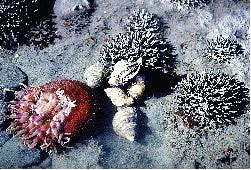 |
Figure
1. Whelks of the species Neptunea pribiloffensis
depositing egg capsule masses near a sea anemone which
will protect the egg masses from predation by sea urchins
during the 12 to 13 months it takes for the eggs to
hatch.
|
|
Figure
2. A single female Neptunea depositing her
egg capsule mass (it is extending downward from under
her foot). It will typically contain dozens of separate
capsules fused into a corn-cob like mass. The sea anemone
she was using as a baby-sitter was located just out
of the picture to the upper left.
|
|
In all of the above reproductive modes
the females typically deposit several dozen to several hundred
egg capsules and each of the capsules contains several thousand
eggs. The capsules are very durable, but will eventually open,
and from each, one to a few small snails will crawl away.
Only a few embryos develop in each capsule, and as they develop
they eat the other non-developing eggs. The length of time
necessary for the development from a tiny egg, a thousandth
of an inch in diameter, in a capsule to a small crawling snail,
up to a third of an inch long, ranges from a few weeks to
over a year, depending on the species.
This type of development is occasionally found in aquaria,
generally by accident. When it occurs, it appears that the
aquarist has added a piece of reef rubble to their tank that
has on it or in it, several egg capsules. Some time after
the rock has been added to the aquarium, the capsules hatch
and all of a sudden the aquarist is forced to confront the
situation that they have a plague of predatory snails in their
tanks. Even if those predators are small and moving at a snail’s
pace they may be able to do a lot of damage.
White Spots On The Walls
Many snails however, don’t go to the extreme seen in
the predatory whelks. They have a reproductive mode that involves
a combination of a transitory or less-durable capsule and
a planktonic embryonic existence. This type of reproduction
is not correlated with the diet of the animals. It is seen
in some of the predatory and scavenging buccinid whelks such
as Nassarius, and also in the herbivorous strombid
conchs, but interestingly enough also in some of the venomous
snails such as the cones and turrids.
Reproduction in these animals probably
involves some sort of courtship behavior, although this has
never been studied, resulting in copulation. As in their distant
cousins, the whelks, sperm may be stored for quite some time.
I studied reproduction in the cold water venomous snail species
Oenopota levidensis, and had an isolated female lay
egg capsules containing viable eggs for over two months, indicating
that she had been able to store sperm from some time before
I put her in her "spawning jar."
These animals typically deposit a clear,
lenticular, round or oval capsule. The capsules are made of
several layers of, presumably, proteinaceous material. Over
the course of their development, diatoms generally do not
grow on them, and they may have some sort of algicide in their
outer layer. Often the upper surface of the capsule appears
to have a long seam, and a plug in the center. The inside
of the capsule is filled with a clear fluid and several eggs
are deposited in it. The number of eggs varies with the species
and with the mother’s size. Larger species and larger
females within the species deposit more eggs.
 |
|
Figure
3. A diagram of the type of egg capsule found on
aquarium walls.
|
These capsules may be deposited on specific surfaces. The
females of one population of Oenopota levidensis that
I studied seemed to search out and deposit their egg capsules
on clam shells. On the other hand, in aquaria, the Nassarius
seem to deposit their eggs on the nearest vertical or near
vertical surface. This nearby surface is often the aquarium
wall, but it may also be a rock, or another snail. Nassarius
capsules are typically small, as befits the small size of
the mother, generally less than 1/32 of an inch across. The
eggs are white and generally from one to about a dozen may
be found in a capsule. On the walls of the aquarium such capsules
are quite noticeable, as the eggs are shiny and white, but
on the rocks they tend to be quite hard to see.
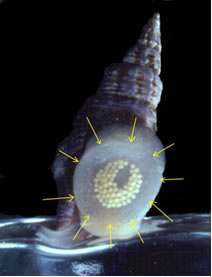 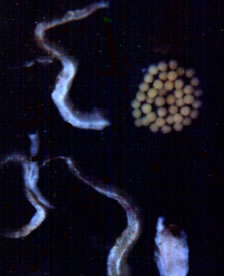 |
|
Figure
4. Left, an Oenopota levidensis female depositing
an egg capsule on the side of a jar. The arrows indicate
the edges of the egg capsule. The eggs are clearly visible
in the capsule. The capsule is secreted by a gland located
in the middle of the foot. Right, a similar egg
capsule photographed in nature on a black rock. The
white structures are calcareous worm tubes.
|
If the capsules on the aquarium wall are
examined with a hand lens, or a good magnifying glass, all
stages of early molluscan embryology may be seen. Right after
deposition, the eggs have not yet begun to develop and are
spherical. Over the next few hours they may be seen to start
to change shape, looking occasionally lumpy and misshapen.
This is the visible manifestation of some rather rapid and
synchronous cell division. After about a day or so, depending
on the temperature of the system, the “eggs” look
to be spherical again, but in this case they now are an embryo
of over 150 cells and they have reached the “blastula”
stage, and form a hollow sphere. During all of this division
the embryo has not grown, in fact, the mass of the embryo
has dropped when compared to that of the egg, as yolk in the
egg has been used up to fuel the development. The blastula
is generally roughly the same size as the egg had been.
 |
|
Figure
5. An Oenopota egg capsule that is a couple
of days old. Although the edges of the embryos is blurry,
the irregular shape indicates that significant larval
development has occurred. The capsule is about 1/16th
of inch across.
|
Shortly after this, the careful observer may begin to see
some interesting changes. The small spheres, no longer eggs,
but looking much as the eggs did, will often start to move.
Generally, at first they may simply spin in place. Sometimes,
however, they will move around inside the fluid contents of
the capsule. This occurs as the surface of the embryo becomes
covered with fine moving cilia. A number of other changes
now start to occur, which may be quite rapid in some species
or quite prolonged in others. In most of the capsules seen
in my aquaria, the changes occur very rapidly.
On close examination, the embryo will be
seen to become irregularly shaped. In fact, it is turning
into a larva, but at the magnification of a hand lens, these
changes are essentially impossible to discern. Primarily,
it is growing some large lobes (large relative to the egg,
the lobes are really pretty small), that it will use in feeding.
Also, the blobby embryo is turning into a recognizable small
snail, and a shell is starting to be secreted. This development
from an embryo to a small larva contained in the egg capsule
can occur in a day or less. Typically, each egg in the capsule
will develop into larvae, but in some species only one or
two will change into larvae. The others may decompose or be
eaten.
 |
|
Figure
6. Oenopota larvae developing inside the
egg capsule.
|
After the change into a larva is complete,
the plug on the top of the capsule (facing into the aquarium)
will open, releasing the larvae into the water. Once the larvae
are into water, they are called veliger larvae and they need
to feed on phytoplankton.
 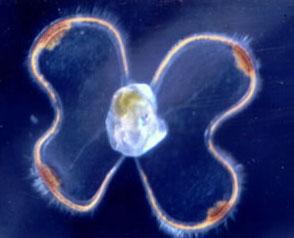 |
|
Figure
7. Left: An Oenopota veliger larva that is
three days post hatching from the capsule. Right:
this larva is ten days old. The green spot in the shell
is algae in the gut, and indicates the animal was feeding.
|
If there is sufficient food, and provided nothing eats them,
these little veligers grow and develop internally becoming
quite complex small snails. Once more depending upon the species,
the length of time that they remain as planktonic larvae varies.
Some are feeding larvae for only a few days, others may be
in the plankton for over a year. It appears some Caribbean
snails may have planktonic veligers that exit the Caribbean
with the Gulf Stream, travel over to Northern Europe, and
back across the Atlantic on the Equatorial Current before
they return back to the Caribbean.
Once the animal has developed sufficiently in the plankton,
it will begin to search out an appropriate bottom substrate.
Often they swim down toward the bottom and “bounce”
along it, presumably “tasting” the bottom for
the appropriate chemical cues. If the correct cues are found,
they quit swimming, settle to the bottom and change into a
crawling small juvenile snail.
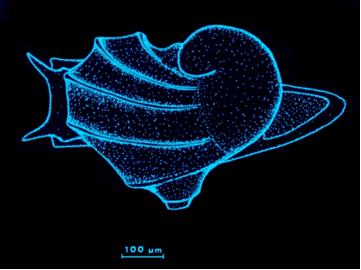 |
|
Figure
8. Newly settled Oenopota juvenile, after
living for about 55 days in the plankton. The animal
is about one mm, or 0.04 inches long.
|
Conclusion:
It is quite possible to raise these animals
all the way from “white spots on the glass” to
small snails. Many useful techniques are listed in my article
and the book by Meg Strathmann cited as “useful references.”
It is far easier to raise these little snails, however, in
special isolated containers such as gallon jars or small aquaria
rather than in reef aquaria, as in such containers it is easier
to provide the food and care that are necessary to maintain
the larvae.
The period from “white spots on the
walls” to a small snail in our tanks is probably on
the order of a month or so for the Nassarius, but may
be more or less than that for other species. In reef aquaria,
there is seldom enough food for the total cycle to be completed,
and additionally there are often a lot of predators on these
small larvae. Everything from fishes to corals will eat them.
Nonetheless, I have received a few reports that seem to indicate
that successful reproduction of such species has occurred
in aquaria. These reports are also becoming more common as
well, perhaps indicating we are being able to more closely
mimic the natural conditions necessary for survival. If you
have success in propagating these animals I would appreciate
knowing about it.
|

